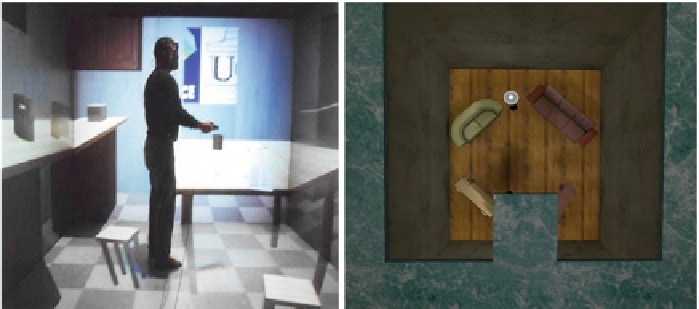Biomedical Engineering Reference
In-Depth Information
Fig. 7.3
Left
UCL's four-walled CAVE™-like display.
Right
looking down into the virtual pit
referred to as CAVE™-like displays (Fig.
7.3
, left), named after the original presen-
tation of such a display [
6
], and the current trademarked commercial version from
Mechdyne Corporation. Again it is hard to draw a line between large wall displays
and SSDs as the most common type of SSD is a CAVE™-like display with four
sides (front, left, right, and floor). Such displays do not completely surround the
user, but when standing in the center of such a system and facing forward, the user's
vision is almost completely filled with the rendered display of the VE. Importantly,
in the most common four-screen configuration the user has peripheral vision of the
VE to his left and right, and also down. Thus the visual cues for motion are more
powerful. The “virtual pit” scene that is often used as a demonstration of the effec-
tiveness of virtual reality [
38
] is especially powerful in a CAVE™-like display with
a floor because the drop is shown near the feet of the user (Fig.
7.3
, right).
Six-sided CAVE™-like systems (Fig.
7.4
) do exist, though there are only a handful
in the world. The engineering of a fully surrounding system of this type is complex
because the floor must be a back-projection screen while being safe for groups of
users to stand upon.
Many variations of SSDs exist in all sorts of display configuration. Domed displays
are common in certain forms of entertainment (e.g., planetariums), though these are
typically used for audiences in the dozens rather than individuals. More exotic dis-
plays include the Allosphere (Fig.
7.5
) at the University of California, Santa Barbara,
a spherical display that supports moderately sized groups [
12
], and the Cybersphere
(Fig.
7.6
)[
9
], a spherical display that supports one person and also acts as a treadmill.
Head-mounted displays (HMDs) are the type of display that is most commonly
associated with the phrase “virtual reality.” While the basic technology has been
available for over thirty years, recently there has been a resurgence in interest and
new displays have come to the market. The advantage of HMDs is that they can create
the impression that the VE fully surrounds the user: as he turns his head the visual
and audio displays can be updated to reflect that motion. This requires some form of
head tracking, whether built into the HMD or attached to it. There are many varieties

